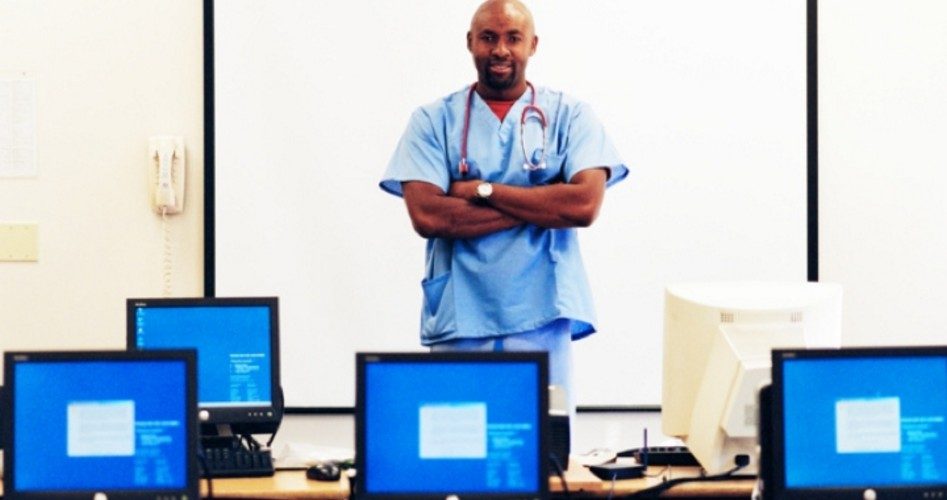
An investigative report released last week helped to shed some light on an issue that is plaguing America’s veterans. According to the report, 1,700 veterans waiting to see a doctor at a Phoenix Veterans Affairs hospital were in fact missing from an official waiting last. The report also revealed that the Veterans Affairs Department is short of 400 doctors. And the National Journal reported that the shortage of doctors is not merely limited to the VA.
“America is running out of doctors,” wrote the National Journal. “The country will be 91,500 physicians short of what it needs to treat patients by 2020, according to the Association of American Medical Colleges. By 2025, it will be short 130,600.”
The highest demand for the Veterans Affairs Department, as well as nationwide, is for primary care physicians, such as general internists, family doctors, and pediatricians — the types of doctors many people go to first for non-emergency medical attention before seeing specialists. In 2012, an Annals of Family Medicine study predicted the country will need 52,000 more primary-care physicians by 2025.
But even as students are enrolling in medical schools in record numbers, those students will not necessarily become doctors in the near future. The National Journal explained, “The number of residencies — crucial stages of medical training — has not risen with the number of applicants, thanks to a government imposed cap.” Organizations such as the Association of American Medical Colleges have been lobbying for a change to the law, asserting that there will not be enough residencies to meet the demands of the incoming young doctors by next year.
“Residency training gives new physicians hands-on experience and provides high-quality care to patients,” said American Medical Association President Jeremy Lazarus, M.D. “Limiting the slots available to train physicians as they leave medical school creates a bottleneck in the system and prevents the physician workforce from growing to meet the needs of our nation’s patients.”
Medical schools and the American Medical Association are working to help generate physicians to meet the growing demand. The AMA website reads:
Medical schools are expanding enrollment and making changes to prepare students for the future practice of medicine, and the AMA has announced a $10 million initiative to further accelerate change in undergraduate medical education. But that is just part of the continuum of medical education essential to produce physicians ready to meet future demands. The number of GME slots has been frozen by the federal government since 1997. As a result, U.S. medical school graduates will exceed the number of available slots as soon as 2015.
“Medical students, patients and physicians who are concerned about protecting GME slots to reduce the physician shortage can contact their elected officials through a new website, SaveGME.org,” said Dr. Lazarus. “Medical students will also be carrying this important message to Congress during their advocacy day on Capitol Hill on February 11. The timing is especially critical as Medicare budget cuts from sequestration could have an impact on funding for graduate medical education.”
In addition to lifting the government-imposed cap, another solution includes expanding the definition of primary care that would allow other healthcare professionals to perform more tasks and even replace doctors in some settings.
A study by the RAND Corporation reveals that expanding medical homes and health centers where nurse practitioners and physician assistants service patients would cut the primary-care physician shortage in half by the year 2025. “Growing use of new models of care that depend more on nonphysicians as primary care providers could do much to reduce the nation’s looming physician shortage,” said David Auerbach, the study’s lead author and a policy analyst at RAND, a nonprofit research organization. “But achieving this goal may require changes in policy, such as laws to expand the scope of practice for nurse practitioners and physician assistants, and changes in acceptance, on the part of providers and patients, of new models of care.”
A report released by RAND Health states:
Both patient-centered medical homes and nurse-managed health centers are models of primary care that use a mix of medical providers that is richer in nurse practitioners and physician assistants than today’s predominant models of delivering medical care.
Medical homes typically use a team-based approach that incorporates physicians, advance practice nurses, physician assistants, pharmacists, nutritionists and other health professionals. They now account for about 15 percent of primary care nationally.
Nurse-managed health centers provide a full range of primary care and some specialty services. They are managed and operated by nurses, with nurse practitioners functioning as the primary care providers. The clinics now account for only 0.5 percent of primary care and typically are affiliated with an academic health center.
Research from the University of California reveals that nurse-managed care could be cheaper than care administered by physicians.
In states that require nurse practitioners to treat patients under the supervision of a physician, the price tag for the clinic visit was $543, while those that allow nurse practitioners to practice on their own carry a price tag of $484 for the clinic visit. According to the researchers, the country could save millions of dollars in healthcare costs if nurse-managed care spread.
If nothing changes, the shortage of doctors will continue to wreak havoc on American healthcare.
While the number of available doctors remains low, the number of patients continues to increase. The problem will become exacerbated as baby boomers age and acquire new health issues, which require more doctor visits. At the same time, baby boomer doctors are nearing retirement age. And as a nation, Americans are sicker than ever before. The National Journal reported that one in five middle-aged adults have more than one chronic health problem, such as hypertension and diabetes.
What does this mean for patients? Most can expect longer wait times and overcrowded waiting rooms. In some cases, physicians are likely to stop accepting new patients.





